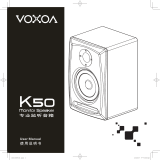
5
• Always unplug the microscope from a power source before opening the base or changing the illumination lamp.
Regardless of the lamp type (halogen or incandescent), give it some time to cool down before trying to change it,
and always change it to a lamp of the same type.
• Always use the power supply with the proper voltage, i.e. indicated in the specications of your new microscope.
Plugging the instrument into a dierent power outlet may damage the electric circuitry of the microscope, burn out
the lamp, or even cause a short circuit.
• Seek medical advice immediately if a small part or a battery is swallowed.
Battery safety instructions
• Always purchase the correct size and grade of battery most suitable for the intended use.
• Always replace the whole set of batteries at one time; taking care not to mix old and new ones,
or batteries of dierent types.
• Clean the battery contacts and also those of the device prior to battery installation.
• Make sure the batteries are installed correctly with regard to polarity (+ and -).
• Remove batteries from equipment that is not to be used for an extended period of time.
• Remove used batteries promptly.
• Never attempt to recharge primary batteries as this may cause leakage, re, or explosion.
• Never short-circuit batteries as this may lead to high temperatures, leakage, or explosion.
• Never heat batteries in order to revive them.
• Remember to switch o devices aer use.
• Keep batteries out of the reach of children, to avoid risk of ingestion, suocation, or poisoning.
• Do not disassemble batteries.
• Utilize used batteries as prescribed by your country laws.
Levenhuk International Lifetime Warranty
All Levenhuk telescopes, microscopes, binoculars and other optical products, except for accessories, carry a lifetime
warranty against defects in materials and workmanship. Lifetime warranty is a guarantee on the lifetime of the
product on the market. All Levenhuk accessories are warranted to be free of defects in materials and workmanship
for six months from date of retail purchase. Levenhuk will repair or replace such product or part thereof which,
upon inspection by Levenhuk, is found to be defective in materials or workmanship. As a condition to the obligation
of Levenhuk to repair or replace such product, the product must be returned to Levenhuk together with proof of
purchase satisfactory to Levenhuk.
This warranty does not cover consumable parts, such as bulbs (electrical, LED, halogen, energy-saving and other
types of lamps), batteries (rechargeable and non-rechargeable), electrical consumables etc.
For further details, please visit our web site: www.levenhuk.com/warranty/
If warranty problems arise, or if you need assistance in using your product, contact the local Levenhuk branch.
Микроскопи Levenhuk LabZZ M101
Обща употреба
Микроскопът Levenhuk LabZZ M101 е безопасен за здравето, живота и имуществото на потребителя, както и
за околната среда, когато се използва правилно, и отговаря на изискванията на международните стандарти.
Микроскопът е предназначен за наблюдение на прозрачни обекти в предавана светлина, използвайки метода
на светлото поле. Може да се използва от деца на възраст над 5 години.
Пакетът включва набор за експерименти Levenhuk K50, който разполага с всичко необходимо, за да подготвите
сами проби за микроскоп. Подробното ръководство ще Ви научи как да подготвяте образци и да провеждате
невероятни експерименти правилно.
Внимание: Децата могат да използват микроскопа само под наблюдението на възрастен.
Пакетът включва:
• Микроскоп
• Обективи: 4х, 10х и 40х
• Окуляр: WF10х – WF16x
• Предметна маса с държач за образци
• Дискова диафрагма
• Вградено светодиодно осветление
• 2 батерии AA
• Набор за експерименти Levenhuk K50
• Ръководство за потребителя и гаранция
BG






